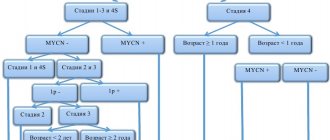| Periventricular leukomalacia | |
| ICD-10 | 91.2 |
| ICD-10-CM | P91.2 |
| ICD-9 | 779.7 |
| ICD-9-CM | 779.7 and 742.8 |
| ICD-O | growth- @ m_s raіtpuTmovtabatf |
| OMIM | MTHU037926 |
| DiseasesDB | 9868 |
| MedlinePlus | 007232 |
| eMedicine | ped/1773 |
| MeSH | D007969 |
Periventricular leukomalacia (PVL)
is a form of damage to the white matter of the cerebral hemispheres in children, discovered by morphologists, one of the causes of cerebral palsy. PVL is characterized by the appearance of foci of necrosis, predominantly coagulative, in the periventricular zones of the white matter of the cerebral hemispheres in newborns (rarely in stillborns). It belongs to one of the forms of the so-called “hypoxic-ischemic encephalopathy”.
Morphology
VR spaces surround the walls of blood vessels and extend from the subarachnoid space through the brain parenchyma. Small VR spaces are popping up across all age groups. With age, VR spaces are found with greater frequency and larger apparent sizes. Upon visual analysis, the signal intensity of the VR spaces is identical to the intensity of the cerebrospinal fluid in all sequences [3].
There are three types of VR spaces:
- Type I VR spaces appear along the lenticulospiral arteries entering the basal ganglia through the anterior perforated substance [3].
- Type II VR spaces are found along the paths of perforating medullary arteries as they enter the cortical gray matter along high bulges and extend into the white matter [3].
- Type III VR spaces appear in the midbrain [3].
Fig.2 Perevascular spaces of type I VR.
Fig. 3 Perevascular spaces of type II VR.
Fig.4 Perevascular spaces of type III VR.
From time to time, VR spaces have an atypical appearance. They can become very large, predominantly involve one hemisphere, take on bizarre shapes, and even have a mass effect. Knowing the signal intensity characteristics and location of VR spaces helps to distinguish them from various pathological conditions [3].
The arteries in the cerebral cortex are covered with a layer of leptomeningocytes, which are lined with the pial membrane; With this anatomical arrangement, the spaces of the intracortical arteries are in direct communication with the spaces of the VR around these arteries in the subarachnoid space [1].
Fig. 5 Multiple cystic-dilated pervascular Virchow-Robin spaces in the white matter of both hemispheres of the cerebrum.
The expansion of RV spaces was described by Durant-Fardel [1] in 1843. The expansions of the perivascular spaces are regular cavities that always contain the patent artery. The mechanisms underlying the expansion of VR spaces are still unknown. Various theories have been put forward: segmental necrotizing arterial angitis or another unknown condition causing permeability of the arterial wall [1], dilation of the ER spaces resulting from disruption of the circulation of interstitial cerebrospinal fluid drainage pathways in the cisterns [1], spiral elongation of blood vessels and brain atrophy, resulting from an extensive network of tunnels filled with extracellular fluid [1], gradual leakage of interstitial fluid from the intracellular space into the pial space in the brain parenchyma [1] and fibrosis with obstruction of the VR spaces along the length of the arteries and subsequent impedance to fluid flow [1].
Fig. 6 Large cystic-dilated pervascular Virchow-Robin space in the area of the basal ganglia on the left.
Etiology and pathogenesis
Etiologically, PVL is a hypoxic-ischemic lesion of the white matter of the brain associated with arterial hypotension, apnea attacks after birth, resuscitation measures, infections, etc. PVL is promoted by prematurity, and of a small degree (1-2nd). Pathogenetic factors: hypoxia, acidosis, hypocapnia, toxins, etc. Foci of necrosis (infarction) occur in the border zone between the ventriculofugal and ventriculopetal arterial branches, localized in the periventricular white matter of the brain.
This nosology is characterized by 2 main signs
:
1. localization in the periventricular zones of the white matter of the cerebral hemispheres 2. lesions have the character of predominantly coagulative necrosis.
Around the PVL foci, other lesions, the so-called “diffuse component,” can be detected.
Time of occurrence of PVL
- mainly in the first days after birth, sometimes ante- and intrapartum.
Epidemiology
The mean age was 58 years (range 24–86 years); the majority (69%) were women [2]. Small VR spaces (<2 mm) are detected in all age groups. With age, VR spaces are found with greater frequency and larger size (> 2 mm) [1]. Some studies have found a correlation between expanded VR spaces and neuropsychiatric disorders [1], multiple sclerosis [1], mild traumatic brain injury [1], and diseases associated with microangiopathy [1].
Frequency
The frequency of PVL, according to different authors, ranges from 4.8% to 88%, but often among a certain group of children or according to neurosonographic studies, which is not entirely objective. On non-selected sectional material, the frequency of PVL is 12.6%, more often in boys, and depending on birth weight: 1001-1500 g - 13.3%, 1501-2000 g - 21.5%, 2001-2500 g - 31.6%, 2501-3000 g - 14.8%, more than 3000 g - 3.5%. It occurs most often in premature infants of the 1st and 2nd degrees. In those who died on the first day after birth, PVL occurs with a frequency of 1.8%, and in those who died on the 6th-8th days - 59.2%. In the group of those born with cephalic presentation, the frequency of PVL is 19.6%, with breech presentation - 17.4%, and with caesarean section - 35.6%.
Differential diagnosis
Lacunar infarctions
Lacunar infarcts are small focal strokes located in the deeper parts of the brain and brain stem. They are caused by obstruction of perforating arteries that arise from the middle cerebral artery, posterior cerebral artery, basilar artery, and less commonly from the anterior cerebral artery or vertebral arteries.
Cystic periventricular leukomalacia
Perientricular leukomalacia, commonly seen in premature infants, is a leukoencephalopathy caused by prenatal or intrapartum hypoxic-ischemic brain injury.
Multiple sclerosis (MS)
MS lesions can be located anywhere in the central nervous system. Lesions in the periventricular and juccarticular white matter correspond to the location of type II VR spaces.
Cryptococcosis
Cryptococcosis is an opportunistic fungal infection caused by Cryptococcus neoformans that affects the central nervous system of patients with human immunodeficiency virus (HIV).
Mucopolysaccharidoses
Mucopolysaccharidoses are inherited metabolic disorders characterized by enzyme deficiency and failure to break down glycosaminoglycan, resulting in the accumulation of a toxic intracellular substrate. Clinical features include mental and motor retardation, macrocephaly, and musculoskeletal deformities. Urinary glycosaminoglycan levels are elevated. Brain atrophy and white matter abnormalities occur.
Cystic neoplasms
Giant dilated VR spaces may cause mass effect and suggest an eccentric location, which may be incorrectly identified as a cystic brain tumor [1]. However, cystic brain tumors often have solid components, enhance with contrast media, and exhibit perifocal edema in most cases.
Neurocysticercosis
Cysticercosis is the most common parasitic infection of the central nervous system, caused by the larval stage of Taenia solia. Fluid oval cysts with an internal scolex (cysticerci) can be located in the brain parenchyma (gray and white matter, but also in the basal ganglia, cerebellum and brainstem), subarachnoid space, ventricles or spinal cord. MR imaging findings for neurocysticercosis vary depending on the stage of infection. Lesions can be observed at different stages in the same patient.
Arachnoid cysts
Arachnoid cysts are intra-arachnoid cerebrospinal fluid-containing cysts that are not connected to the ventricular system.
Neuroepithelial cysts
Neuroepithelial cysts are rare and benign lesions that are mostly asymptomatic. Their etiology is controversial, but the underlying developmental anomalies are undeniable. The lesions are spherical, up to several centimeters in size, and may have a mass effect. They are lined with thin epithelium and have a cerebrospinal fluid signal. Neuroepithelial cysts may occur in the lateral or fourth ventricles, with which they do not communicate (intraventricular cysts). They can also be found within the cerebral hemispheres, thalamus, midbrain, pons, cerebellar vermis and medial temporal lobe [1]. Neuroepithelial cysts are not contrasted [1]. Differentiation between neuroepithelial cysts and dilated VR spaces can only be confidently made by pathological examination.
Description history
The first microscopic description of a PVL focus belongs to JM Parrot (1873). R. Virchow only macroscopically described yellowish foci in the periventricular zones of the lateral ventricles of the brain in deceased newborns born to mothers with syphilis and smallpox, classifying them as congenital encephalitis. There are no sufficient grounds to classify these lesions as PVL. The lesion has been described under various names (“encephalodystrophy”, “ischemic necrosis”, “periventricular infarction”, “coagulative necrosis”, “leukomalacia”, “cerebral softening”, “periventricular white matter infarction”, “white matter necrosis”, “diffuse symmetrical periventricular leukoencephalopathy"), more often by German scientists, but the term “periventricular leukomalacia”, introduced in 1962 by BA Banker and JC Larroche, became widespread worldwide. The term is not clear enough, since with PVL it is not softening that occurs, but foci of coagulation necrosis that are denser than the surrounding areas of the brain. The first article in the USSR and Russia dedicated to PVL was written by V.V. Vlasyuk et al. (1981), who proposed using the term “periventricular leukomalacia.”
The most complete studies of PVL in the world on the largest sectional material were carried out by V.V. Vlasyuk (1981) (frequency, etiopathogenesis, topography, degree of damage to various parts of the brain, stages of development of lesions, neurohistology, role of microglia, electron microscopy, etc.), who for the first time revealed a high frequency of damage to the optic radiance and proved that PVL is a persistent process, that old foci of necrosis can be joined by new ones, that PVL foci can be at different stages of development.
Sources
- "Virchow-Robin Spaces at MR Imaging." Robert M. Kwee, Thomas C. Kwee link
- "Large anterior temporal Virchow-Robin spaces: unique MR imaging features." Lim AT1, Chandra RV, Trost NM, McKelvie PA, Stuckey SL. link
- "Virchow-Robin spaces at MR imaging." Kwee RM1, Kwee TC. link
Author: radiologist, Ph.D. Vlasov Evgeniy Alexandrovich
Full or partial reprint of this article is permitted by installing an active hyperlink to the source
If you still have doubts about the conclusions of your MRI, you can order a review of your study with a detailed transcript here:
Differences from other lesions
In very premature infants, other lesions of the white matter of the brain other than PVL are more likely to occur - diffuse leukomalacia and multicystic encephalomalacia. Due to insufficient knowledge of the latter lesions, they are often mistakenly classified as PVL.
PVL must be differentiated
with the following main lesions of the white matter of the cerebral hemispheres:
- edematous hemorrhagic leukoencephalopathy (OHL)
- telencephalic gliosis (TG)
- diffuse leukomalacia (DFL)
- subcortical leukomalacia (SL)
- periventricular hemorrhagic infarction (PVI)
- intracerebral hemorrhage (ICH)
- multicystic encephalomalacia
- subependymal pseudocyst.
In LS, foci of necrosis are located in the subcortical region and in some severe cases can spread to the central parts of the cerebral hemispheres. In DFL, foci of necrosis are located diffusely in all parts of the white matter of the brain, involving the periventricular, subcortical and central regions of the cerebral hemispheres; colliquation necrosis leads to cyst formation and occurs most often in very premature infants. With TG there is no complete necrosis of the brain and cysts do not form. PGI occurs due to thrombosis in the system of internal cerebral veins or is a complication of intraventricular hemorrhage. Pseudocysts have nothing to do with brain necrosis and are most likely developmental defects. The pathogenesis of all these lesions is different.
Currently, there is an overdiagnosis of PVL due to the overestimation of neuroimaging studies and underestimation of other lesions of the white matter of the brain.








